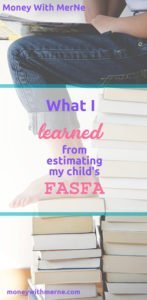I decided to try the online FAFSA4caster to estimate potential federal aid for which my TODDLER would be eligible when he enters college. I didn’t even know what the government considered when calculating aid, so this was a good opportunity to find out. And the early research means I have plenty of time to change my investment and saving strategies to prepare. Even if you don’t have a child or don’t think you will, you may find this post interesting to see what the government considers “sheltered” (my own words).
I roughly understood that there was a distinction between parents’ money and the student’s money. If you have the choice, it’s better to have money in the parents’ names than in the child’s. So we are making sure that we are not setting up any accounts in my child’s name even though we may have certain accounts or investments earmarked for him.
The main form requirements include the adjusted gross income (from a recent tax return) and “assets” for both the parents and the student. What is an asset, I said? Well, thanks to a pop-up window, I found out!
Assets include:
- Money in cash, savings, and checking accounts
- Businesses
- Investment farms
- Other investments, such as real estate (other than the home in which you live), UGMA and UTMA accounts for which you are the owner, stocks, bonds, certificates of deposit, etc.
Assets do not include:
- The home in which you live
- UGMA and UTMA accounts for which you are the custodian, but not the owner
- The value of life insurance
- Retirement plans (401[k] plans, pension funds, annuities, non-education IRAs, Keogh plans, etc.)
My conclusions after reading these definitions is that when you have extra money it’s better to:
- Pay off debt
- Fund retirement accounts – either a 401k or IRA
You would want to avoid non-retirement stock market investments and rental real estate properties.
So all of you out there (with kids) who think you “should be” investing in the stock market outside of retirement?? Stop feeling this pressure! Your money can be spent elsewhere to achieve equally-important financial goals and set yourself up better for financial assistance for college.
I set a goal at the beginning of this year to contribute monthly to an S&P index fund and I want to complete that goal, but 2018 will be different. 2018 will be about mortgage principle payments and increased 401k contributions. I don’t really love the 401k because I won’t be able to access that money until I’m 59.5 and my ambitious goal is to retire well before then, but as I’m already maxing out both my and my husband’s Roth IRAs, I’m left with the 401k (or traditional IRAs). As my son gets closer to college, I want to minimize my income AND assets, while still having enough to cover our living expenses. I’m wondering if I can manage to “retire” (aka quit our jobs) a year or 2 prior to my son being college age and live off of any remaining non-retirement investments to reduce both income and assets.
Those of you that don’t have a Roth IRA yet and meet the income requirements, I urge you again to open an account if you have extra money in your monthly budget! With this retirement option, you can withdraw your CONTRIBUTIONS at any time without penalty (whereas your investment GROWTH cannot be withdrawn until the age of 59.5) so if you are lucky enough to retire early, you can withdraw from a Roth to bridge the gap until you are eligible to withdraw from your 401k. And it’s better to open a Roth sooner versus later as you become ineligible when you reach a certain income. Even if early retirement is not in the cards for you, a Roth can be used as a kind of emergency fund – and the bonus when college comes into play is that these funds would not count toward your FAFSA assets like a basic liquid savings account would.
There are real advantages to “sheltering” your money through paying off debt and funding retirement, so don’t worry about becoming a Wall Street trading aficionado, focus on the basics!!





It is interesting to examine the arbitrary rules they have picked to determine need for aid. One thing that I find particularly strange is that an investment account and the highly advertised 529 both count against you when calculating aid. As you mentioned, the Roth IRA is a great alternative, because it is sheltered from FAFSA, and contributions can be withdrawn without tax penalties.